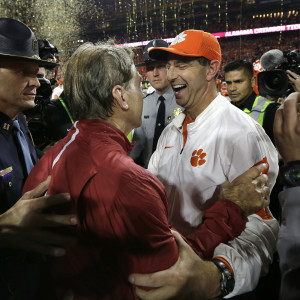A long-standing debate recurs every time a college football player suffers a career-threatening injury: Should college athletes be paid? After all, in a violent sport, players risk suffering a career-ending injury.
In a normal labor market, employees who take on risks are compensated for it. But the list of NCAA football players who suffer debilitating injuries keeps growing. It’s obvious to many that college players should be paid for the risks they take and the value they create. But there’s another consequence of the system that’s often overlooked. Because college players can’t be paid, the money that would go to them in a normal labor market shifts to other parts of the program — like coaches.
NCAA football generates billions in revenue for schools with teams. Five athletic conferences bring in more than $250 million annually. Yet the labor force that’s largely responsible for producing this good — the players — cannot receive monetary compensation because of a combination of factors.
First, the NFL requires players to be at least three years removed from high school graduation before they’re eligible to play pro ball. Even “NFL-ready players” who are only one year out of high school have little choice but to play college football in order to maintain and showcase their skills until they’re “old enough” to play professionally.
Second, the NCAA keeps member universities from offering players a salary in excess of room, board and tuition. The NCAA is effectively a cartel — an organization of independent entities that acts as a cohesive unit — to which all who want to play football professionally must donate three years of service.
Ohio State University’s football coach, Urban Meyer, recently said that collegiate coaches are overpaid. He’s right, but not because his job consists of playing a game. If that were true, athletes and coaches in the NFL would also be overpaid — but their salaries are largely determined by the demand for their product (the latest Super Bowl was the most watched broadcast in U.S. television history). The reason college coaches are overpaid is because the salaries of their employees — the players — aren’t determined by market forces.
The salaries that would be paid to the players is instead paid to the coach. That’s why Jim Harbaugh can quit the NFL, go to the University of Michigan, and still get the same compensation he made in the NFL. Can you imagine any other situation where one can move from a large, for-profit institution to a smaller, “non-profit” organization, do the exact same job, and not take a pay cut?
When direct payments to the players cannot be made, indirect payments are. Because the schools aren’t allowed to make monetary payment, they pay in other ways. It’s amazing how much money is available when you don’t pay labor.
With the funds that would have gone to athlete salaries, for example, schools spend additional funds on locker rooms, weight rooms, training facilities, and spend more money on tutors, advisers, trainers and coaches. Because the coaches influence an athlete’s odds of going pro, a large part of these funds get placed in the coach’s contract. Thus college coaches aren’t receiving a market wage; it’s artificially inflated.
This is an inefficient use of resources. The resources that go to upgrading facilities and bidding wars for popular coaches should be paid directly to the players. It’s reminiscent of the 1970s, when passenger airlines couldn’t change their fares; prices were set by the Civil Aeronautics Board. So airlines competed in other dimensions — for example, by finding better flight attendants or offering fancier, “free” in-flight dining.
Once that market was deregulated, however, it quickly became apparent that many passengers prefer no-frills, low-cost air service — and now we have a robust market that serves consumers a broad assortment of air travel, suited to fit each traveler’s demands.
To increase the efficiency of payments to college players, universities should pay them directly. If schools feel that student-athletes shouldn’t be paid while they’re in school, the funds could be held until after college — maybe even paying a bonus for those who graduate. That’s a nice incentive for the athletes taking on the risk. They should be compensated for it.

